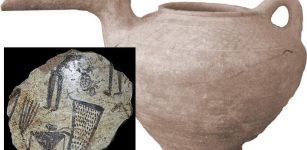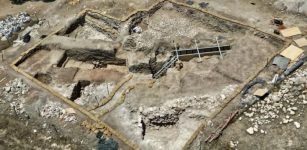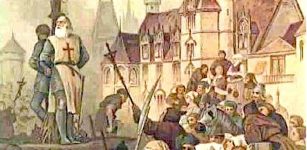Mystery Of The Maya Blue Pigment And Its Unusual Chemical Composition
Ellen Lloyd - AncientPages.com - The Maya Blue has been a scientific puzzle mainly due to its unusual chemical composition. Maya blue is a highly resistant artificial pigment. Despite the time and the harsh weathering conditions, paintings colored in Maya blue have not faded over time. However, the blue dye could be destroyed with intense acid under reflux.
The Maya Blue (azul maya in Spanish) has been discovered at several architectural locations from the ancient Mayan civilization, including the archaeological site of Cacaxtla on the Mural de la batalla.
This pigment was named Maya blue because it was thought to exist only in the Maya area of Yucatan. Today, it is known that there are murals with Maya Blue in various parts of Mesoamerica, as in the Tajin, Tamuín, Cacaxtla, and Tenochtitlan (Templo Mayor), Zaachila, Tula, and other parts of Central America. The pigment has also been found on palace walls, ceramics, codices, sculptures, and even the bodies of human sacrifices.
Maya blue first appeared around 800 and was still used in the 16th century.
The recipe and process for preparing Maya Blue, a highly-resistant pigment used for centuries in Mesoamerica, were lost. Bonampak is an ancient Maya archaeological site in the Mexican state of Chiapas featuring Maya Blue pigment. Credit: Darij & Ana, Wikipedia, Creative Commons
Scientists have long known the two chief ingredients of the intense blue pigment: indigo, a plant dye used today to color denim, and palygorskite, a type of clay. However, how the ancient Maya produced unfading paint remained a mystery.
The history of the Maya blue began in 1931 when scientists analyzed a bluish substance found in the exploration of the Temple of the Warriors in Chichén Itzá (Yucatan). Since then, scientists from different countries have dedicated their efforts to unlocking this compound's secrets.
Some years ago, scientists from the University of Valencia in Spain discovered traces of another pigment in Maya Blue. "We detected a second pigment in the samples, dehydroindigo, which must have formed through oxidation of the indigo when it underwent exposure to the heat required to prepare Maya Blue," Antonio Doménech, a researcher from the University of Valencia, said. It could solve the Maya Blue mystery.
"Indigo is blue, and dehydroindigo is yellow. Therefore the presence of both pigments in variable proportions would justify the more or less greenish tone of Maya Blue," Doménech explained. "It is possible that the Maya knew how to obtain the desired hue by varying the preparation temperature, for example, heating the mixture for more or less time or adding more or less wood to the fire."
In 2008, American scientists claimed that copal resin, which was used for incense, may have been the third secret ingredient for Maya Blue. Their research was based on a study of a bowl that had traces of the pigment and was used to burn incense. However, Doménech remains skeptical and remarked that the bowl contained Maya Blue mixed with copal incense, so the simplified conclusion was that it was only prepared by warming incense.
Credit: Constantino Reyes - Public Domain
The Egyptian blue is the world’s oldest artificial pigment. It appeared about 5,000 years ago in a tomb painting dated to the reign of Ka-sen, the last king of Egypt’s First Dynasty. Blue dye was also used in ancient Egypt. The chemical composition remains unknown, at least for now.
Scientists have discovered that the Egyptian blue pigment has extraordinary properties and will enable us to reconstruct the past and possibly shape the technological future.
The material giving Egyptian blue its color is calcium copper silicate. It was made by grinding sand, lime, and copper (or copper ore) and heating the mixture in a furnace.
Could the answer to the secret ingredient for Maya Blue be hidden in the composition of the ancient Egyptian blue pigment?
Ancient Egyptians used blue pigment in paintings, such as wall paintings, tombs, mummies’ coffins, and ceramics.
Updated on June 26, 2022
Written by Ellen Lloyd - AncientPages.com
Expand for referencesReferences:
More From Ancient Pages
-
 Daily Life Of A Lady In Waiting – A Dangerous Profession Sometimes
Ancient History Facts | Aug 24, 2023
Daily Life Of A Lady In Waiting – A Dangerous Profession Sometimes
Ancient History Facts | Aug 24, 2023 -
 Pharaoh Hor Aha – 1st Dynasty Ruler Of Ancient Egypt Who Founded The City Of Memphis And May Have Been The Legendary Menes
Featured Stories | Jun 23, 2018
Pharaoh Hor Aha – 1st Dynasty Ruler Of Ancient Egypt Who Founded The City Of Memphis And May Have Been The Legendary Menes
Featured Stories | Jun 23, 2018 -
 Surprising Evidence Prehistoric People In Survived In The Coldest Regions Of Spain
Archaeology | Oct 6, 2023
Surprising Evidence Prehistoric People In Survived In The Coldest Regions Of Spain
Archaeology | Oct 6, 2023 -
 ‘Yunatsite’ And Thought-Provoking Theory That Balkan Peninsula And Not Mesopotamia Was The Cradle Of Civilization
Featured Stories | Feb 14, 2023
‘Yunatsite’ And Thought-Provoking Theory That Balkan Peninsula And Not Mesopotamia Was The Cradle Of Civilization
Featured Stories | Feb 14, 2023 -
 Gravitational Waves Shed Light On The Mysterious Antikythera Mechanism
News | Jun 29, 2024
Gravitational Waves Shed Light On The Mysterious Antikythera Mechanism
News | Jun 29, 2024 -
 900-Year-Old Crypt At Old Dongola: Magical Inscriptions And Mysterious Signs Found
Archaeology | Sep 12, 2015
900-Year-Old Crypt At Old Dongola: Magical Inscriptions And Mysterious Signs Found
Archaeology | Sep 12, 2015 -
 Legend Of Sleeping Hero Holger Danske: Viking Warrior Who Never Died
Featured Stories | May 8, 2016
Legend Of Sleeping Hero Holger Danske: Viking Warrior Who Never Died
Featured Stories | May 8, 2016 -
 Oldest Human Genome From The Iberian Peninsula Helps Reconstructing Human History
Archaeology | Mar 1, 2023
Oldest Human Genome From The Iberian Peninsula Helps Reconstructing Human History
Archaeology | Mar 1, 2023 -
 Monumental Grave Of Ancient Greek Poet Aratus Located In Mersin- But It Cannot Be Opened
Archaeology | Jun 4, 2017
Monumental Grave Of Ancient Greek Poet Aratus Located In Mersin- But It Cannot Be Opened
Archaeology | Jun 4, 2017 -
 7,000-Year-Old Tepe Ozbaki Mounds Yielded Valuable Relics – But Now The Site Is In Trouble
Archaeology | Nov 25, 2020
7,000-Year-Old Tepe Ozbaki Mounds Yielded Valuable Relics – But Now The Site Is In Trouble
Archaeology | Nov 25, 2020 -
 War Between Romans And Persians Lasted 721 Years: One Of The World’s Longest Human Conflicts In History
Featured Stories | Apr 18, 2022
War Between Romans And Persians Lasted 721 Years: One Of The World’s Longest Human Conflicts In History
Featured Stories | Apr 18, 2022 -
 7,000-Year-Old Underwater Road Discovered In Adriatic Sea Off Korcula Island
Archaeology | May 11, 2023
7,000-Year-Old Underwater Road Discovered In Adriatic Sea Off Korcula Island
Archaeology | May 11, 2023 -
 Mysterious Moon-Eyed People – Ancient Subterranean Race In Conflict With The Cherokee
Featured Stories | Dec 28, 2017
Mysterious Moon-Eyed People – Ancient Subterranean Race In Conflict With The Cherokee
Featured Stories | Dec 28, 2017 -
 Anglo-Saxon Kings Were Mostly Vegetarians Before Vikings Settled In England
Archaeology | Apr 21, 2022
Anglo-Saxon Kings Were Mostly Vegetarians Before Vikings Settled In England
Archaeology | Apr 21, 2022 -
 Gigantic Viking Age Burial Ground With Artifacts And 50-Meter-Long Shipwreck Unearthed In Tvååker, Halland, Sweden
Archaeology | Oct 18, 2024
Gigantic Viking Age Burial Ground With Artifacts And 50-Meter-Long Shipwreck Unearthed In Tvååker, Halland, Sweden
Archaeology | Oct 18, 2024 -
 Astonishing Pre-Inca Salt Ponds of Maras In Peru Were Created By The Chanapata Culture
Civilizations | Sep 14, 2016
Astonishing Pre-Inca Salt Ponds of Maras In Peru Were Created By The Chanapata Culture
Civilizations | Sep 14, 2016 -
 Mysterious Massive 3,800-Year-Old Structure And Passageway Found In The Jezreel Valley, Israel
Archaeology | Aug 23, 2023
Mysterious Massive 3,800-Year-Old Structure And Passageway Found In The Jezreel Valley, Israel
Archaeology | Aug 23, 2023 -
 Unexplained Visions Of Airmen – Strange Presence And Disturbances – Part 1
Featured Stories | Feb 6, 2020
Unexplained Visions Of Airmen – Strange Presence And Disturbances – Part 1
Featured Stories | Feb 6, 2020 -
 Susa: One Of The World’s Oldest Cities That Served As Capital Of The Elamite Empire
Featured Stories | Oct 14, 2023
Susa: One Of The World’s Oldest Cities That Served As Capital Of The Elamite Empire
Featured Stories | Oct 14, 2023 -
 On This Day In History: Knights Templars’ Jacques de Molay Burned At The Stake – On Mar 18, 1314
News | Mar 18, 2017
On This Day In History: Knights Templars’ Jacques de Molay Burned At The Stake – On Mar 18, 1314
News | Mar 18, 2017


